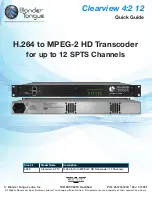
®
N7491-1V1 5/98
5819WHS/5819BRS
SHOCK PROCESSOR
TRANSMITTER
INSTALLATION INSTRUCTIONS
For use with QED control panels ONLY!
GENERAL INFORMATION
The 5819WHS/5819BRS Shock Processor Transmitters
feature a built-in shock sensor and are intended for use
only with a wireless alarm system that supports Ademco
QED 5800 Series wireless receivers.
The built-in shock sensor is used to detect forcible attack
upon the surface to which it is mounted. It is designed to
protect window and door surroundings. The sensor is
electrically normally closed, but, under shock conditions,
goes open circuit momentarily.
The 5819 supports three unique zones, known as "loops":
Loop 1 = built-in shock sensor loop factory wired to
TB1 (normally closed)
Loop 2 = built-in magnetic reed switch in conjunction
with a magnet (normally closed)
Loop 3 = externally wired, closed circuit contact loop
connected to TB2
For U.L. installations, a contact may not be more than 3
feet from the transmitter.
The 5819 also has a built-in cover tamper switch which
activates when the cover is removed and sends a "check"
message to the control.
Area of Shock Protection
Typical area of coverage is 10 -12 feet (5-6 foot radius).
This can vary depending on the type of window or other
mounting surface to which the unit is mounted.
MOUNTING
The description that follows assumes that the unit will be
mounted as shown in the diagram, with the magnet (if
used) located to the left of the unit. The unit can be
installed in any direction, as long as the relationship of the
unit to the magnet is maintained. In addition, the arrow
embossed on the built-in shock sensor must face UP when
the unit is mounted.
To change the shock sensor's orientation, gently push the
sensor away from its mounting hole until it can rotate
freely. Twist the sensor until the arrow is pointing UP when
the detector is in the desired mounting position, then
gently push the sensor until it is fully seated in its mounting
hole.
Before mounting the transmitter permanently, conduct
Go/No Go tests (see QED control's instructions) to verify
adequate signal strength and reorient or relocate the
transmitter if necessary.
1. Remove transmitter's cover by inserting the flat blade
of a small screwdriver into the pry-off slot nearest to the
cover's decorative ribs, and twisting the blade.
2. If using a wired contact loop, cut the thin "breakout"
area provided at the lower edge in the case wall to
allow wire entry.
3. Mount the case back to a solid surface using the two
holes provided in the unit (holes 'A" in Diagram 1).
4. If using the unit's reed switch, mount a 5899 Magnet
(obtained separately) adjacent to the alignment marks
on the case (see Diagram 1).
5. If using an external contact, remove the battery (if
installed) and connect a normally closed contact to
TB2.
NOTE: If the contact loops are not used, make no
connection across the terminals.
A
+
–
BA
TTER
Y
REED
SWITCH
(LOOP 2)
COVER PRY-OFF POINT
ALIGN MAGNET
WITH MARKS
ON CASE
MAGNET
(OBTAIN
SEPARATELY)
LOOP 1 TERMINALS
(Built-in shock sensor)
See Detail “B”
COVER
HOLDING
HOOKS (2)
COVER
TAMPER
SWITCH
HOLES “A” (2)
(SEE TEXT)
ANTENNA
DIP SWITCHES
See Detail “A”
DIP
SWITCHES
JUMPER PINS
See Detail “B”
A
MAGNET
1
/
2
”
MAX
1
2
3
4
5
ON
TB2
TB1
TABLE 1
SWITCH
RESPONSE TIME
SW1 (Most Sensitive)
1ms
SW2
2ms
SW3
5ms
SW4
10ms
SW5 (Least Sensitive)
20ms
JUMPER
PINS
BUILT-IN
SHOCK SENSOR
TERMINALS
(INPUT LOOP 1)
TABLE 2
JUMPER
COUNT
J1 (Most Sensitive)
1
J2
2
J3
4
J4
6
J5 (Least Sensitive)
8
J5 J4 J3 J2 J1
DETAIL B
DETAIL A
LOOP 3 TERMINALS
See Detail “B”
DETAIL C
Embossed arrow on
shock sensor must
point UP when unit
is mounted.
“BREAKOUT” FOR
WIRE ENTRY
CONTACT
TERMINALS
(INPUT LOOP 3)
SHOCK SENSOR
See Detail “C”




















